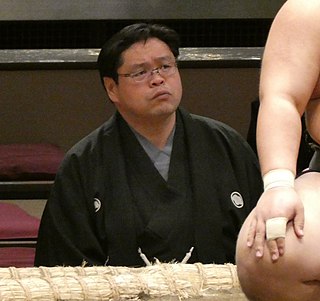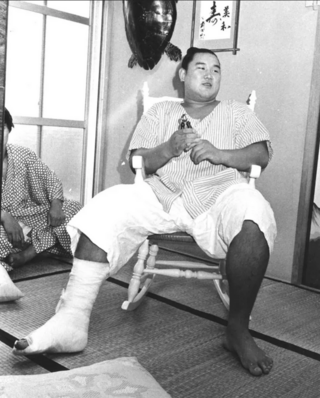Takamiyama Daigorō is an American-born Japanese former professional sumo wrestler. Wrestling for Takasago stable for twenty years from 1964 to 1984, his highest rank was sekiwake. Takamiyama set a number of longevity records in sumo, including most tournaments ranked in the top makuuchi division, and most consecutive top division appearances. In July 1972, he became the first foreign-born wrestler to win the top division championship. He is also the first foreign-born wrestler ever to take charge of a training stable, founding Azumazeki stable in 1986. His most successful wrestler was fellow Hawaiian Akebono who reached the sport's highest rank of yokozuna in 1993. Takamiyama retired as a coach in 2009.

Kaiō Hiroyuki is a former professional sumo wrestler from Nōgata, Fukuoka, Japan.

Kotonishiki Katsuhiro is a former sumo wrestler from Takasaki, Gunma Prefecture, Japan. He began his career in 1984, reaching the top makuuchi division in 1989. He won two top division tournament titles from the maegashira ranks, the first in 1991 and the second in 1998. His highest rank was sekiwake, which he held 21 times. He earned eighteen special prizes during his career, second on the all-time list, and defeated yokozuna eight times when ranked as a maegashira. He retired in 2000 and after a long stint as a sumo coach at Oguruma stable, took the vacant elder name Asahiyama and branched out to form his own stable of the same name.

Takasago stable is a stable of sumo wrestlers, one of the Takasago group of stables. It is correctly written in Japanese as "髙砂部屋", but the first of these kanji is rare, and is more commonly written as "高砂部屋".

Miyabiyama Tetsushi is a former sumo wrestler from Mito, Ibaraki, Japan. A former amateur champion, he turned professional in 1998. With the exception of two tournaments, he was ranked in the top division of professional sumo from 1999 until the end of his career in 2013, holding the second highest rank of ōzeki from 2000 to 2001. He won eight special prizes and was runner-up in four top division tournaments. He wrestled for Fujishima stable, where he worked as a coach until opening his own Futagoyama stable.

Takanonami Sadahiro was a Japanese sumo wrestler and coach from Aomori. He held sumo's second highest rank of ōzeki from 1994 until 2000. He won two tournament championships, and was a runner-up in eight others. He was a sumo coach from his retirement in 2004 until his death in 2015 at the age of 43.

Takanohana stable was a stable of sumo wrestlers, created in 2004 when Takanohana Kōji took over the running of Futagoyama stable from his father Takanohana Kenshi. Formerly of the Nishonoseki ichimon or group of stables, it became the leader of a breakaway Takanohana group in 2010, which was formally recognized as an ichimon in 2014. It is one of the most successful sumo stables with 42 top division championships to its name, won by eight different wrestlers, if Futagoyama's history from 1962 is included. As of the September 2018 tournament the stable had eight wrestlers, including three sekitori. Takanohana resigned from the Japan Sumo Association shortly after that tournament and the stable was absorbed into Chiganoura stable on October 1, 2018.

Tosanoumi Toshio, is a former sumo wrestler. He first reached the top division of professional sumo in 1995, winning 13 special prizes and earning 11 kinboshi or gold stars for defeating yokozuna over his long career. The highest rank he reached was sekiwake. He retired in 2010 to become a coach at his stable, Isenoumi stable under the name of Tatekawa.

Tochinonada Taiichi is a former sumo wrestler from Ishikawa Prefecture, Japan. An amateur sumo champion, he turned professional in 1996 and reached the top makuuchi division in 1997. He earned twelve kinboshi or gold stars for defeating yokozuna, the second highest ever, and he was a runner-up in two tournaments. His highest rank was sekiwake. He is now a coach at Kasugano stable under the name Takenawa Oyakata.

Wakanosato Shinobu is a retired sumo wrestler from Hirosaki, Aomori, Japan. He made his debut in the top division in 1998, and his highest rank was sekiwake. He holds the record for the most consecutive tournaments ranked in the junior san'yaku ranks of sekiwake and komusubi. He won ten special prizes and was twice runner-up in a tournament. He earned two gold stars for defeating yokozuna at a maegashira rank. He had 1691 career bouts, sixth on the all-time list. He retired in 2015 and was a coach at Tagonoura stable, until opening his own Nishiiwa stable in February 2018.

Maenoyama Tarō was a sumo wrestler from Osaka Prefecture, Japan. He began his career in 1961, reaching the top makuuchi division in 1966. His highest rank was ōzeki which he held from 1970 until 1972. He retired in 1974 and became head coach of the Takadagawa stable. He left the Sumo Association in 2010 upon turning 65.

Takadagawa stable is a stable of sumo wrestlers, one of the Nishonoseki ichimon or group of stables. It was formed in 1974 by former ōzeki Maenoyama, and was originally in the Takasago group of stables before joining the Nishonoseki ichimon. A series of wrestlers from Taiwan were recruited in the late 1980s. Later a Mongolian, Maenoyu, was at the stable from 2004 until 2007, but there have been no foreigners recruited since Maenoyu's retirement and the current stablemaster has indicated there are no plans to do in the immediate future. As of January 2023, it had 19 wrestlers.

Takamisugi Takakatsu is a former sumo wrestler from Kawasaki, Kanagawa, Japan. His highest rank was komusubi. He is now the head coach of Tokiwayama stable, renamed from Chiganoura stable.
The following are the events in professional sumo during 2004.
The following are the events in professional sumo during 2003.
In 1999, Musashimaru firmly established his position as the dominant sumo wrestler of the year. Born in American Samoa and raised in Hawaii, Musashimaru became only the second foreign-born wrestler in history to achieve the highest rank of yokozuna or grand champion, in May 1999. He finished the year having won four tournaments, a rare accomplishment.
The following are the events in professional sumo in 1998.
In 1996, the Kyushu Grand Sumo Tournament set a record for the number of wrestlers in a playoff, after Musashimaru, Akebono, Wakanohana, Takanonami, and Kaio, all tied at 11–4. Musashimaru won the historic five-way playoff, taking his second tournament title since July 1994.
In 1995, yokozuna Takanohana finished in first place, while fellow yokozuna Akebono ranked second. The third-ranked sumo wrestler was ōzeki Wakanohana, who took the championship title at the November Kyūshū Basho after winning in a playoff against his brother Takanohana, the first tournament bout between brothers in the history of sumo.

Dewanishiki Tadao was a sumo wrestler from Tokyo, Japan. His highest rank was sekiwake. He won ten kinboshi or gold stars for defeating yokozuna during his long top division career, which only four wrestlers have bettered. He also won four special prizes. After his retirement he was a coach at Dewanoumi stable.














